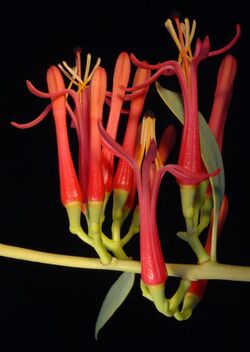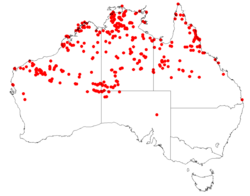Biology:Amyema sanguinea
| Amyema sanguinea | |
|---|---|

| |
| Amyema sanguinea | |
| Scientific classification | |
| Kingdom: | Plantae |
| Clade: | Tracheophytes |
| Clade: | Angiosperms |
| Clade: | Eudicots |
| Order: | Santalales |
| Family: | Loranthaceae |
| Genus: | Amyema |
| Species: | A. sanguinea
|
| Binomial name | |
| Amyema sanguinea | |

| |
| Collections data for A. sanguinea from the Australasian Virtual Herbarium | |
| Synonyms | |
|
Treubella muelleriana Tiegh. | |
Amyema sanguinea is an aerial hemiparasitic shrub within the genus Amyema, in the family Loranthaceae[4][5] and native to Australia, where it is found in New South Wales, Queensland, the Northern Territory, South Australia and Western Australia.[6]
Description
Its leaves are flat and opposite (sometimes appearing alternate).[7] Its inflorescence is a simple umbel with 3-6 flowers, on a stem.[7] Flowering from January to December, its erect flowers[8] shade from pinky-red to an orange-red.[5] The yellow stamens do not project beyond the corolla.[8] The mature buds have six ribs.[8]
Ecology
A. sanguinea is usually found on eucalypts, but is sometimes found on Melaleucas or Acacias.[5] Downey's list of hosts gives 33 eucalyptus hosts.[9] It is used by at least seven species of moths and butterflies (Delias argenthona, Candalides margarita gilberti, Hippochrysops digglesii, Ogyris amaryllis meridionalis, Ogyris iphis doddi, Ogyris zosine and Comocrus behri).[8]
Taxonomy
A. sanguinea was first described by Ferdinand von Mueller as Loranthus sanguineus in 1859.[10] Danser, in 1929, allocated the species to the genus, Amyema in 1929.[2]
References
- ↑ "Australian Plant Name Index (APNI): Ammyema sanguinea (Muell.) Danser". https://biodiversity.org.au/nsl/services/name/apni/87527/api/apni-format. Retrieved 11 May 2018.
- ↑ 2.0 2.1 Danser, B.H. 1929. On the taxonomy and nomenclature of the Loranthaceae of Asia and Australia. Bulletin du Jardin Botanique de Buitenzorg ser. 3, 10(3): 298
- ↑ World Plants: Synonymic Checklists of the Vascular Plants of the World
- ↑ Roskov, Y., Kunze, T., Orrell, T., Abucay, L., Paglinawan, L., Culham, A., Bailly, N., Kirk, P., Bourgoin T., Baillargeon, G., Decock, W., Wever, A., Didžiulis, V. (ed) 2014. "Species 2000 & ITIS Catalog of Life: 2014 Annual Checklist". Species 2000: Reading, UK.. http://www.catalogueoflife.org/annual-checklist/2014/details/species/id/16865334. Retrieved 26 May 2014.
- ↑ 5.0 5.1 5.2 "FloraBase: Amyema sanguinea". https://florabase.dpaw.wa.gov.au/browse/profile/2385. Retrieved 11 May 2018.
- ↑ "AVH: Amyema sanguinea (mapview), Australasian Virtual Herbarium". http://avh.ala.org.au/occurrences/search?taxa=Amyema+sanguinea#tab_mapView. Retrieved 11 May 2018.
- ↑ 7.0 7.1 Barlow, B.A. 1984. "Flora of Australia Online: key to Amyema, Data derived from Flora of Australia Volume 22, a product of ABRS, ©Commonwealth of Australia". http://www.anbg.gov.au/abrs/online-resources/flora/stddisplay.xsql?pnid=48296. Retrieved 11 May 2018.
- ↑ 8.0 8.1 8.2 8.3 Moss, J.T. & Kendall, R. 2016. The mistletoes of subtropical Queensland, New South Wales and Victoria,Butterfly & Other Invertebrates Club
- ↑ Downey, PO 1998. "An inventory of host species for each aerial mistletoe species (Loranthaceae and Viscaceae) in Australia. Cunninghamia 5, 685-720.". https://www.rbgsyd.nsw.gov.au/getmedia/45da9206-5752-4403-a295-f62d4de172a0/Volume-5(3)-1998-Cun5Dow685-720.pdf.aspx.
- ↑ von Mueller, F.J.H. 1859. Fragmenta Phytographiae Australiae 1(7): 177
Wikidata ☰ Q15377687 entry
 |

